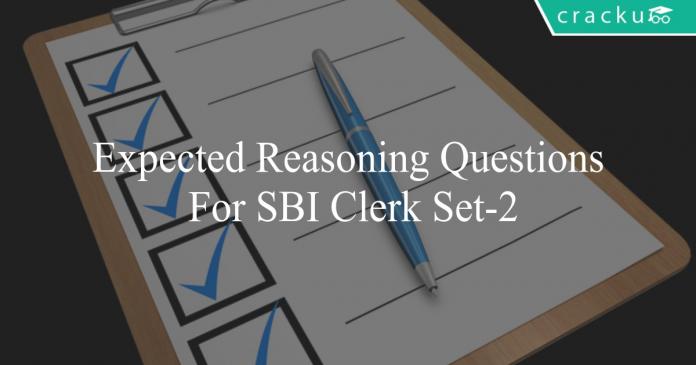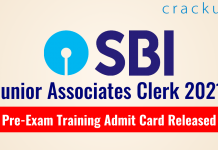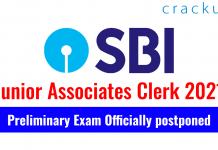Expected Reasoning Questions For SBI Clerk Set-2
Download SBI Clerk Expected Reasoning Questions & Answers PDF for SBI Clerk Prelims and Mains exam. Very Important SBI Clerk Expected Reasoning questions with solutions.
Download Expected Reasoning Questions For SBI Clerk Set-2
790+ Mocks – Just Rs. 194. Use coupon: SBIDREAM70
Download SBI Clerk Puzzles Set-1 PDF
Question 1: In the following question, select the related letters from the given alternatives.
GAFT : PJOC :: WORS : ?
a) FXBA
b) FAXB
c) FXAB
d) FXJB
Question 2: Find the option that should replace the (?) so that the second pair bears the same relationship as the first pair:
84:48::73: ?
a) 56
b) 16
c) 40
d) 36
e) 46
Instructions
Study the following information and answer the questions given below.
If,
A # B means A is father of B
A & B means A is husband of B
A @ B means A is sister of B
A % B means A is daughter of B
Question 3: Which of the following should replace question mark (?) such that P is son-in-law of T?
P & Q (?) R & S @ T
a) %
b) @
c) &
d) #
e) Either A or B
Download SBI Clerk Previous Papers PDF
Take a free mock test for SBI Clerk
Question 4: Which of the following shows that E is sister-in-law of A?
a) A & B @ C % F @ D & E
b) A @ B & C % D @ E & F
c) A & B % C # D @ E % F
d) More than one of the options above
e) None of these
Instructions
8 colleagues (A,B,C,D,E,F,G,H) are sitting around a rectangular table and facing in opposite direction alternatively. Four of the colleagues are sitting on the corners and four of them are sitting on the edges of the table. Each of the colleague belongs to Mumbai, New Delhi, Chennai, Kolkata, Hyderabad, Jaipur, Indore and Chandigarh (not in that order). The cities Mumbai, New Delhi, Kolkata and Chennai are called metros. It is also known that :
Everyone sitting at the corner faces towards the table. People from metros do not sit opposite each other. H sits in a corner opposite the person from New Delhi. The person sitting third to the right of A who is from Chennai, is from New Delhi. B from Chandigarh sits opposite to F from Kolkata and they both face each other. C from Indore sits third to the left of H, who is from Jaipur. G sits opposite to the person from Indore and is second to the right of E who is from Hyderabad. D faces the table.
Question 5: Which amongst the following does not face the table ?
a) The person from New Delhi
b) The person from Kolkata
c) The person from Mumbai
d) The person from Chandigarh
e) Cannot be determined
Question 6: Who sits left of the person from Chennai ?
a) C
b) H
c) G
d) A
e) Cannot be determined
Instructions
Choose which of the conclusion(s) follow(s) based on the statements given:
Question 7: $ E \geq D$; $ A = C$; $ A > B$; $ F = E$; $ B < D$;
Conclusions:
I: $ E > A$
II: $ F \leq C$
a) Only conclusion I is true.
b) Only conclusion II is true.
c) Either conclusion I or conclusion II is true.
d) Both the conclusions are true.
e) Neither of the conclusions is true.
Banking Study Material – 18000 Questions
Question 8: $ R = S$; $Q \geq P$; $S < T$; $ T > Q$;
Conclusions:
I: $ T \geq P$
II: $ R \leq Q$
a) Only conclusion I is true.
b) Only conclusion II is true.
c) Either conclusion I or conclusion II is true.
d) Both the conclusions are true.
e) Neither of the conclusions is true.
Instructions
Directions: Triangle($\blacktriangle$) represents 1 and Circle($\circ$) represents 0. If triangle appears in unit’s place, then its value is 1. If it appears in ten’s place, then its value is doubled to 2 and so on.
For example:
$\blacktriangle$ = 1
$\blacktriangle \circ \blacktriangle \blacktriangle$ = 8+0+2+1 = 11
$\circ \blacktriangle \blacktriangle$ = 0+2+1 = 3
Question 9: What will be the code for 18 in this language?
a) $\blacktriangle\circ\circ\circ\blacktriangle$
b) $\blacktriangle\circ\circ\blacktriangle\circ$
c) $\blacktriangle\circ\blacktriangle\circ\blacktriangle$
d) $\blacktriangle\circ\blacktriangle\circ\circ$
e) None of these
Question 10: What is the value of $\blacktriangle \blacktriangle\blacktriangle\circ$?
a) 13
b) 12
c) 11
d) 14
e) None of these
Instructions
Answer the following questions based on the flow chart provided:

Question 11: The program can be best described as
a) gives the quotient when a number is divided by 3
b) gives the remainder when a number is divided by 3.
c) gives the number that must be subtracted to make the given number divisible by 3
d) gives the number that has to be added to make the given number divisible by 3
e) gives the number that must be multiplied to make the given number a perfect square.
Question 12: If the program displays n+k as output instead of n-k, then what will be the output when k =5 will be
a) 10
b) 12
c) 2
d) 1
e) 11
Instructions
Each of the questions below consist of a question and two statements. You have to decide whether the data provided in the statements is sufficient to answer the questions. Read both the statements and then choose the appropriate option.
Question 13: Who is the eldest among A, B, C, D, E?
I. C is neither the youngest nor the eldest and B is younger to only one person. B’s age is the average of C and D.
II. There are as many people as old as E as there are younger to him. The age of B is twice that of E.
a) The data in statement I alone is sufficient to answer the question but the data in statement II alone is not sufficient to answer the question
b) The data in statement II alone is sufficient to answer the question but the data in statement I alone is not sufficient to answer the question
c) The data in either of the statements is sufficient to answer the question
d) The data in both statements together is also not sufficient to answer the question
e) The data in both the statements is necessary to answer the question
Question 14: Which floor does R stay on a seven storeyed building, where the lowest floor is numbered 1 and the highest floor numbered 7?
I. Only two people live above S, who lives below R.
II. There are as many people above R as there are below T, both of whom live on prime numbered floors.
a) The data in statement I alone is sufficient to answer the question but the data in statement II alone is not sufficient to answer the question
b) The data in statement II alone is sufficient to answer the question but the data in statement I alone is not sufficient to answer the question
c) The data in either of the statements is sufficient to answer the question
d) The data in both statements together is also not sufficient to answer the question
e) The data in both the statements is necessary to answer the question
Instructions
In each question given below a statement is followed by three Courses of action numbered I, II and III. A course of action is a step or administrative decision to be taken for improvement follow up or further action in regard to the problem, policy etc. on the basis of the information given in the statement. You have to assume every thing in the statement to be true, then decide which of the three given/ suggested Courses of action logically follows for pursuing and decide the answer.
Question 15: Statement :
The chairman of the car company announced in the meeting that all trials of its first product the new car model ‘M’ are over and company plans to launch its car in the market after six months.
Courses of action :
(I) The network of dealers is to be finalised and all legal, financial and other matters in this connection will have to be finalised shortly.
(II) The company will have to make plan for product other than car.
(III) Material, managerial and other resources will have to be in fine tune to maintain production schedule
a) I and III only
b) Only I
c) All of three
d) Only II
e) None of these
Instructions
In making decisions about important questions, it is desirable to be able to distinguish between ‘strong’ arguments and ‘weak’ arguments so far as they relate to the question. ‘Strong’ arguments are those which are both important and directly related to the questions. ‘Weak’ arguments are those which are of minor importance and also may not be directly related to the questions or may be related to a trivial aspect of the question. The question below is followed by two arguments numbered I and II. You have to decide which of the arguments is a ‘strong’ argument and which is a ‘weak’ argument.
Give answer a: if only argument I is strong
Give answer b: if only argument II is strong
Give answer c: if either I or II is strong.
Give answer d: if neither I nor II strong.
Give answer e: if both I and II are strong.
Question 16: Should all the power generation and distribution units in the State Y be handed over to the private sector ?
Arguments :
I. Yes, the State Government are not equipped to handle generation and distribution of electricity efficiently and it is not bene cial too.
II. Yes, The private companies handle generation and distribution of electricity efficiently.
a) if only argument I is strong
b) if only argument II is strong
c) if either I or II is strong.
d) if neither I nor II strong.
e) if both I and II are strong.
Instructions
Study the following information and answer the questions given below.
Sam started from his home towards his office. He walked 12 metres towards South and turned left at point A. He then walked 35 metres and turned right at point B. Then he walked 16 metres and turned left at point C. Finally he walked 10 metres and stopped at his office.
Question 17: Find the shortest distance between his home and his office?
a) $54\sqrt{3}$ metres
b) $53$ metres
c) $51\sqrt{2}$ metres
d) $47$ metres
e) None of these
Question 18: Find the shortest distance between his home and point B?
a) $34\sqrt{3}$ metres
b) $37$ metres
c) $31$ metres
d) $47\sqrt{2}$ metres
e) None of these
Question 19: 40
a) Figure 1
b) Figure 2
c) Figure 3
d) Figure 4
e) Figure 5
Question 20: 39
a) Figure 1
b) Figure 2
c) Figure 3
d) Figure 4
e) Figure 5
General Knowledge Questions & Answers PDF
Answers & Solutions:
1) Answer (C)
The logic followed here is (n + 9). Hence, the code for GAFT will be,
G + 9 = P, A + 9 =J, F + 9 = O, T + 9 = C.
Similarly, the code for WORS is,
W + 9 = F, O + 9 = X, R + 9 = A, S + 9 = B.
Hence, option C is the correct answer.
2) Answer (C)
$84 = 8^2 – 4^2 = 64 – 16 = 48$
Using the same logic,
$73 = 7^2 – 3^2 = 49 – 9 = 40$.
Therefore, option C is the right answer.
3) Answer (A)
By putting % in the blank,
P & Q → P is husband of Q
Q % R → Q is daughter of R
R & S → R is husband of S
S @ T → s is sister of T.
Here, P is husband of Q who is niece of T.
Hence, P is son-in-law of T.
4) Answer (C)
By checking Option C,
A & B → A is husband of B
B % C → B is daughter of C
C # D → C is father of D
D @ E → D is sister of E
E % F → E is daughter of F
Here, E is sister of B who is A’s wife.
Hence, E is sister-in-law of A.
5) Answer (C)
Let us assign H a corner and work our way from there. The person sitting opposite to H is from New Delhi. This means that H cannot be from a metro. The person sitting third to the right of A who is from Chennai, is from New Delhi which means that the person sitting third to the right of the person from New Delhi is A from Chennai. Now the arrangement will look like this :

H is from Jaipur and person sitting third to the left of H is from Indore. G sits opposite to the person from Indore. The person from Hyderabad is second to the right of G. Now the arrangement will look like this :

B from Chandigarh and F from Kolkata face each other which means that they must sit on the corners. This means that G is from Mumbai as one out of pair of people sitting opposite to each other is from a metro. We also know that the person from Indore is C. Since D faces the table, we know that D is sitting on one of the corners. Since only one corner is left, we know that D is the person from New Delhi. This also means that the person from Hyderabad is E. Now the arrangement will look like this :

From the figure, we can see that from the given options, G the person from Mumbai does not face the table.
6) Answer (B)
Let us assign H a corner and work our way from there. The person sitting opposite to H is from New Delhi. This means that H cannot be from a metro. The person sitting third to the right of A who is from Chennai, is from New Delhi which means that the person sitting third to the right of the person from New Delhi is A from Chennai. Now the arrangement will look like this :

H is from Jaipur and person sitting third to the left of H is from Indore. G sits opposite to the person from Indore. The person from Hyderabad is second to the right of G. Now the arrangement will look like this :

B from Chandigarh and F from Kolkata face each other which means that they must sit on the corners. This means that G is from Mumbai as one out of pair of people sitting opposite to each other is from a metro. We also know that the person from Indore is C. Since D faces the table, we know that D is sitting on one of the corners. Since only one corner is left, we know that D is the person from New Delhi. This also means that the person from Hyderabad is E. Now the arrangement will look like this :

From the figure, A is from Chennai who faces away from the table. Thus, H from Jaipur is left of A.
7) Answer (C)
The given statements can be combined and expressed as $ C = A > B < D \leq E = F$.
$F \leq C$ can be written as $ A \geq E$.
The 2 conclusions, state that $ A < E $ or $ A \geq C$.
One among these 2 conclusions must definitely follow.
Therefore, either conclusion I or conclusion II follows. Therefore, option C is the right answer.
8) Answer (E)
The given statements can be combined as $R = S < T > Q \geq P$.
$T$ is greater than $Q$. Therefore, $T$ is definitely greater than $P$. Conclusion I is false since it states that $T \geq P$.
No relationship can be established between $R$ and $Q$ since there is a change in the sign of the inequality. Therefore, conclusion II does not follow.
Neither of the conclusions follow. Therefore, option E is the right answer.
9) Answer (B)
18 can be written as 16+0+0+2+0 = $\blacktriangle\circ\circ\blacktriangle\circ$
10) Answer (D)
$\blacktriangle \blacktriangle\blacktriangle\circ$ = 8+4+2+0 = 14
11) Answer (D)
The logic can be explained as follows.
First, it is checked whether the input is less than 0. If it is not, then we increment ‘n’ by 3 and recheck whether the given number is less than or equal to ‘n’. The process is repeated till ‘n’ becomes equal to or greater than the input.
Finally, the input is subtracted from ‘n’. Thus, we get the number that must be added to make the given number divisible by 3.
Hence, option D is the right answer.
12) Answer (E)
The logic can be explained as follows.
First, it is checked whether the input is less than 0. If it is not, then we increment ‘n’ by 3 and recheck whether the given number is less than or equal to ‘n’. The process is repeated till ‘n’ becomes equal to or greater than the input.
Finally, the input is subtracted from ‘n’. Thus, we get the number that must be added to make the given number divisible by 3.
So, when k=5, n=6. If n+k is displayed as the output, then 5+6 = 11 will be the output.
13) Answer (A)
From I, B is younger only to one person. B’s age is the average of C and D. D is the eldest as C is neither the youngest nor the eldest.
II – There are as many people as old as E as there are younger to him. The age of B is twice that of E.
Nothing can be concluded from II.
14) Answer (B)
From II,
We can conclude that only such possibility is that R lives on 5 and T on 3.
Thus, option B is the correct answer.
15) Answer (A)
Once the trails are over, the best availability of material managerial and other resources is necessary to maintain production schedule. Hence III follows.
As mentioned in the statement, ‘model M is its first product’, so it is necessary to finalise the network of dealers and all matters regarding the sale of the product. Hence I follows. II has no connection with the statement.
Thus, only I and III follow.
=> Ans – (A)
16) Answer (D)
17) Answer (B)
The below diagram can be drawn using given statements.

Shortest distance between his home and his office $= \sqrt{28^2 + 45^2} = \sqrt{784+2025} = \sqrt{2809} = 53$ metres
18) Answer (B)
The below diagram can be drawn using given statements.

Shortest distance between his home and his office $= \sqrt{12^2 + 35^2} = \sqrt{144+1225} = \sqrt{1369} = 37$ metres
19) Answer (A)
20) Answer (A)
We hope this Expected Reasoning Question & Answers PDF of SBI Clerk is very Useful for preparation of SBI Clerk Exams.





